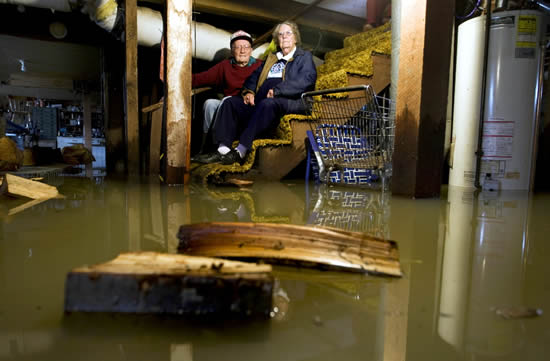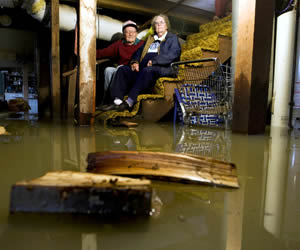
A wet basement can be obvious—water trickling across the floor or standing several inches deep at the base of the stairs. But there also are less obvious signs.
A wet basement may just feel humid and have a damp, stuffy smell. If so, wood in contact with concrete may be wet or decaying. Efflorescence, a chalky white substance left by the evaporation of water, maybe seen on the walls. Basement floor tiles may be loose or popped. A carpeted floor may smell musty.
Find the Water
Fixing a wet basement begins with finding the cause. Infiltration of surface water, infiltration of groundwater, presence of outside humidity, and presence of indoor humidity are common causes of wet basements. Surface water intrusion is when water runs toward the foundation and finds an entry. Groundwater enters through the walls and floor by wicking action or by hydrostatic pressure when the surrounding soil is saturated or the water table is high.
Warm, moist summer air can enter a house and condense on the basement’s cooler floor or walls. Indoor activities, like an improperly vented dryer, can create humidity that settles in the basement.
Fix the Problem
To avoid ongoing problems with mold or mildew, get rid of any water-damaged furnishings and possessions unless they can be properly cleaned. Then identify and treat the source of the problem.
Surface Water
If surface water is the culprit, watch how the roof drainage system works and where rainwater flows during a rainstorm. A gutter or downspout plugged with debris may be sending rainwater over the gutter, down along the foundation, and into the house. Regular cleaning or installing a gutter guard that prevents debris from getting into the trough will end that problem.
If there is no debris but rainwater is still overflowing, the downspouts may be clogged, incorrectly sized for the roof area, or insufficient for the size of the house. Consider getting larger gutters, adding another downspout, or increasing the downspout size and its corresponding gutter opening.
Downspout extensions that direct rainwater away from the house may be improperly placed or not long enough to protect the home from surface water. Experts suggest extensions of at least 10 feet to get the discharge away from the house without sending water into a neighbor’s yard.
Check the grade to see if it has been improperly set or has settled in spots, sending water toward the foundation. Check paved areas, driveways, and walkways that may be directing water toward the house. The proper slope has to be regained and may mean replacing pavement.
Basement window wells and stairwells can collect water, causing leaks into the basement. For a window well, put a drain system underneath, cover it with a clear plastic cover and be sure the well has a raised-lip edge to repel water. For a stairwell, consider a raised-lip edge and a roof to cover the area.
Groundwater
Groundwater is difficult to control. The ground surrounding a basement may become saturated with rainwater or an underground spring, especially if the soil is heavy clay. Water pressure from saturated soil will push water through tiny cracks in the foundation. If groundwater levels rise above the basement floor, water will leak in.
If the problem is small, a homeowner may try patching cracks from the inside. Interior crack repair does not prevent water from getting into the exterior section of the wall. Water trapped inside the basement wall can weaken the foundation. After pinpointing the source, a homeowner might dig down along the foundation to see if outer wall repairs are small or large before making a repair decision. Large cracks may require a structural engineer or basement specialist to fix any cracks, seal the outside, and install a drain around the perimeter of the house.
Humidity
Warm moist air, from inside activities or the outside, can condense on cooler basement walls and floors. Install energy-efficient windows, use a dehumidifier or air conditioner, and circulate household air to prevent moisture buildup. Indoor humidity can have several sources. A working sump pump can produce unwanted humidity but can be easily controlled. Put a tight-sealing cover on the sump pump and install a floor drain with a trap so that water can get to the sump.
A dirt floor or crawl space may also emit moisture. One possibility is to pour a concrete floor over a sealed polyethylene moisture barrier on the floor. For crawl spaces, a ground cover will reduce the moisture coming up through the earth. Insulate perimeter walls if water pipes or heating ducts are in that area. Insulate cold-water pipes and walls. Install proper dryer exhausts and vent basement showers directly outside. Don’t hang wet laundry in the basement.
Fixing a wet basement may mean replacing decaying wood. If wood supports or framing appear water damaged, check with a professional to see if there are structural problems. – Bob vila

